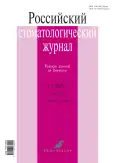Experimental evaluation of the chemical composition of dental cement in adults
- Authors: Malina M.S.1,2, Tytyuk S.Y.1,3, Iordanishvili A.K.1,3
-
Affiliations:
- International Academy of Ecology, Human and Nature Safety
- Medical and Social Institute
- Military Medical Academy named after S.M. Kirov
- Issue: Vol 25, No 1 (2021)
- Pages: 12-16
- Section: Experimental and Theoretical Investigation
- URL: https://journals.rcsi.science/1728-2802/article/view/89224
- DOI: https://doi.org/10.17816/1728-2802-2021-25-1-12-16
- ID: 89224
Cite item
Abstract
BACKGROUND: Information about the chemical composition of tooth root cement is limited, although it can contribute to clarifying the mechanisms of tooth root surface caries development and in improving methods of its treatment and prevention.
AIM: This study aimed to investigate the chemical composition of cement in intact teeth and in teeth with root caries in adults of different age groups.
MATERIALS AND METHODS: The average Ca, P, and Ca/P-coefficient in the cement of the intact teeth and in the caries of the root was obtained, and a tendency toward a decrease in the total mineralization of the cement in the caries of the root was also found.
RESULTS: In adults experiencing hyperesthesia of hard dental tissues, regardless of age and sex, the morphological picture is similar and is determined by pathological changes of carious and non-carious origin in tooth tissues that cause hyperesthesia.
CONCLUSIONS: Moderate and severe hyperesthesia of the hard tissues of the adult teeth results in a decrease in the level of mineralization in the enamel, dentin, as well as in cement relative to the intact teeth.
Full Text
##article.viewOnOriginalSite##About the authors
Maria S. Malina
International Academy of Ecology, Human and Nature Safety; Medical and Social Institute
Author for correspondence.
Email: tmos2005@yandex.ru
ORCID iD: 0000-0002-0703-7274
Russian Federation, 74, Bolshoy Prospekt Vasilyevsky Island, 199026, Saint Petersburg; Saint Petersburg
Sergey Yu. Tytyuk
International Academy of Ecology, Human and Nature Safety; Military Medical Academy named after S.M. Kirov
Email: sergei_tytyuk@mail.ru
MD, Cand. Sci. (Med.)
Russian Federation, 74, Bolshoy Prospekt Vasilyevsky Island, 199026, Saint Petersburg; Saint PetersburgAndrey K. Iordanishvili
International Academy of Ecology, Human and Nature Safety; Military Medical Academy named after S.M. Kirov
Email: professoraki@mail.ru
MD, Dr. Sci. (Med.)
Russian Federation, 74, Bolshoy Prospekt Vasilyevsky Island, 199026, Saint Petersburg; Saint PetersburgReferences
- Iordanishvili AK. Parodontologiya. Saint Petersburg: Chelovek; 2020. (In Russ).
- Iordanishvili AK, Idris AY. Compliance and health: the social aspect of the problem. Ecology and Development of Society. 2019;(3):59–60. (In Russ).
- Iordanishvili AK. Geriatricheskaya stomatologiya: rukovodstvo dlya vrachei. Saint Petersburg: Chelovek; 2019. (In Russ).
- Iordanishvili AK. Gerontostomatologiya. Saint Petersburg: Chelovek; 2015. (In Russ).
- Iordanishvili AK. Vozrastnye izmeneniya zhevatel'no-rechevogo apparata. Saint Petersburg: Chelovek; 2015.
- Iordanishvili AK, Lobeiko VV, Zhmud MV, et al. Frequency and causes of functional disorders of salivation in people of different ages. Adv Gerontol. 2012;25(3):531–534. (In Russ).
- Lobeyko VV, Iordanishvili AK. Ray sialoadenopaty in older people and their treatment. Bulletin of the Russian Military Medical Academy. 2014;(1):75–79. (In Russ).
- Lobeyko VV, Ryzhak GA, Dyakonov MM, Iordanishvili AK. Treatment of reactive and distrofisesky diseases of sialadens at people of advanced and senile age. Kuban Scientific Medical Bulletin. 2015;(1):69–74. (In Russ). doi: 10.25207/1608-6228-2015-1-69-74
- Pikhur OL. Vozrastnye izmeneniya sostava i stroeniya tverdykh tkanei zuba. Saint Petersburg: Nordmedizdat; 2015. (In Russ).
Supplementary files








